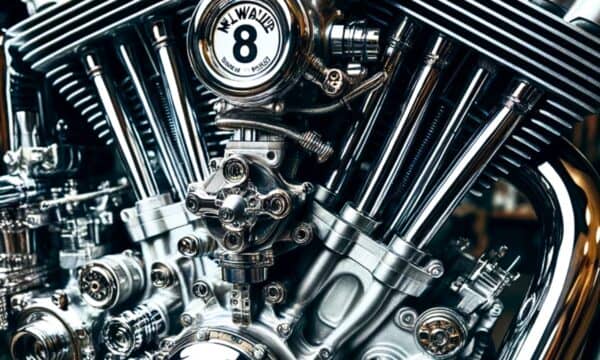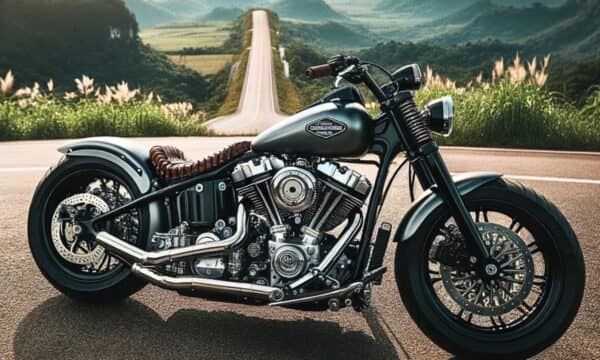The Milwaukee 8-engine life expectancy is a topic that interests Harley Davidson owners greatly.

This engine is renowned for its performance, but how long it lasts is determined by several factors, including maintenance, riding style, and overall care.
In this article, we will dive into the specifics of the Milwaukee 8 engine’s life expectancy and factors that could influence it.
Let’s get started!
Milwaukee 8 Engine Life Expectancy
The Milwaukee 8 engine was designed to provide a long-lasting, reliable powerplant for the Harley-Davidson touring models.
This engine can last over 100,000 miles with regular maintenance and proper care.

There are reports of some owners having more than double that amount before needing any major repairs or rebuilds.
However, many factors determine how long an engine will last, such as the type of riding and how well it has been maintained.
A Milwaukee 8 engine can last for decades with proper care and maintenance.
History and Development
The Milwaukee 8 engine, an innovative creation by Harley-Davidson, boasts an impressive lifespan owing to its historic developments.
The engine’s inception traces back to 2016 when Harley launched it as a replacement for the Twin Cam engine that had served riders for almost two decades.
The Milwaukee 8 engine features four valves per cylinder, totaling eight valves, which is a nod to its name.
Here are a few key features and specifications that make it stand out:
- It boasts a powerful and efficient engine with a generous size and capacity
- The Milwaukee 8 engine delivers impressive power and torque, ensuring a thrilling and dynamic performance
- It has advanced cooling systems that effectively regulate the engine temperature, enhancing overall reliability
Factors Influence Life Expectancy
1. Manufacturing Quality
The manufacturing quality of the Milwaukee 8 engine has a direct impact on its life expectancy.
High-quality manufacturing processes ensure the engine’s components are crafted to the finest detail.
Precision in manufacturing minimizes wear and tear and reduces the likelihood of mechanical failures.
Suitable quality materials used in production can withstand higher temperatures and pressures, further enhancing the engine’s lifespan.
2. Maintenance Practices
It also significantly impacts the life expectancy of the Milwaukee 8 engine.
Regular oil changes, for instance, are crucial as fresh oil lubricates the engine parts more efficiently, reducing wear and tear.
High-quality oil and filters extend the engine’s lifespan by offering better protection against contaminants.
Regularly inspecting and replacing the air filters can stop dirt and debris from entering the engine, which causes damage over time.
Also, keeping the engine at optimal operating temperature ensures the cooling system functions correctly.
3. Riding Habits
If a rider frequently pushes the engine to its limits, with high revs and hard accelerations, the engine life may decrease.
On the other hand, regular and gentle riding can prolong the engine’s lifespan.
So, you can keep the engine healthier and long-lasting by maintaining a steady speed, avoiding rapid acceleration, and ensuring regular engine checks.
4. Environmental Factors
Predominantly, the quality of air also plays a crucial role. In areas with excess dust, dirt, or other airborne particles, these contaminants can enter the engine, causing wear on internal parts.
Heat and cold can cause the engine materials to expand or contract, leading to structural damage over time.
On the other hand, moisture, especially in areas with high humidity or frequent rainfall, can lead to rust and corrosion of engine parts.
Therefore, regular maintenance and protective measures against these environmental elements will ensure a longer lifespan for your Milwaukee 8 engine.
Common Issues with Milwaukee 8 Engines
1. Oil Pump Issues
Like any mechanical device, Milwaukee 8 can undergo issues, one of the common ones being oil pump problems.
The oil pump maintains optimal engine operation by lubricating the engine’s components.
If pumps fail, it can lead to engine overheating, abnormal noise, and even severe engine damage if not addressed promptly.
A few signs of a failing oil pump include low oil pressure, increased engine operating temperature, and oil light coming on.
2. Cooling System Problems
Unlike traditional engines, Milwaukee 8 relies heavily on liquid cooling to maintain optimal operating temperatures.
However, this cooling system can sometimes falter, which leads to overheating and engine damage.
The most common reasons are clogged coolant passages and malfunctioning water pumps.
Clogged passages can restrict coolant flow, while a failing water pump cannot effectively circulate the coolant.
In this situation, checking components for signs of wear and tear and ensuring the coolant is topped up to prevent these issues.
Real-world Data and Case Studies
1. Average Lifespan Data
When discussing its lifespan, we focus on two main aspects: the miles it can run, and the years it can serve without significant breakdowns.
Riders have shared instances of this engine running smoothly for over 40,000 miles and even crossing the 100,000-mile mark, highlighting its potential for longevity.
Compared to other engines, the Milwaukee 8 often stands out for its ability to balance power and durability. It provides a reliable riding companion for years and adventures to come.
This engine delivers a powerful ride and promises a journey that stands the test of time.
2. User Experiences and Testimonials
Many owners share tales of smooth rides, praising the engine for its robust performance and reliability on the road.
For instance, one rider clocked in an impressive 43,000 miles in just over two years on their 107 models.
While another celebrated reaching 45,000 miles on their 2018 FLHTK, reflecting the engine’s potential for durability and longevity.
Conversely, some users have navigated through a few bumps, encountering issues requiring troubleshooting and repairs.
Wrapping Up
The Milwaukee 8 engine has been found to have a longer life expectancy than other similar engines due to its improved performance and higher-quality components.
It is an efficient and reliable powertrain that will save you time and money in the long run.
Maintenance of this engine is critical to ensuring its longevity, as regular oil changes and inspections can help you prevent unexpected breakdowns.
FAQs
How does regular maintenance impact the Milwaukee 8 engine?
Regular maintenance significantly improves the performance and longevity of the Milwaukee 8 engine.
It ensures smooth and efficient operation, reduces wear and tear, and prevents unexpected breakdowns.
What are some common issues with the Milwaukee 8 engine?
These include problems with excessive heat, oil pump failures leading to decreased performance, and issues with the rocker arm shafts causing abnormal noise.
How does the Milwaukee 8 engine compare to its predecessors?
This engine outperforms its predecessors by offering more power and smoother running. It has four valves per cylinder, improving airflow and combustion efficiency.
You may like to read!

Ahtsham Younas is a passionate blogger and content writer. He loves to ride motorcycles and learn the mechanical process behind the motorcycles.
He has been writing articles in the motorcycle industry since 2019 and has learned many things about motorbike niches.


